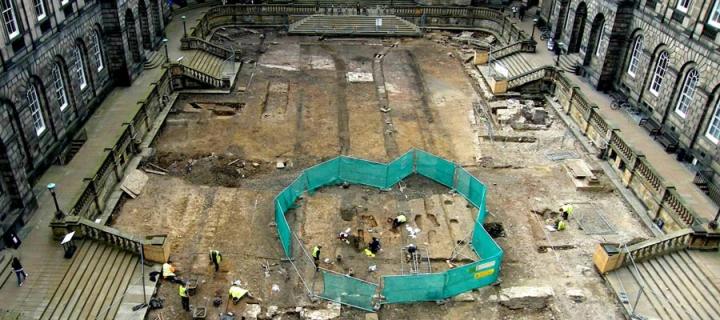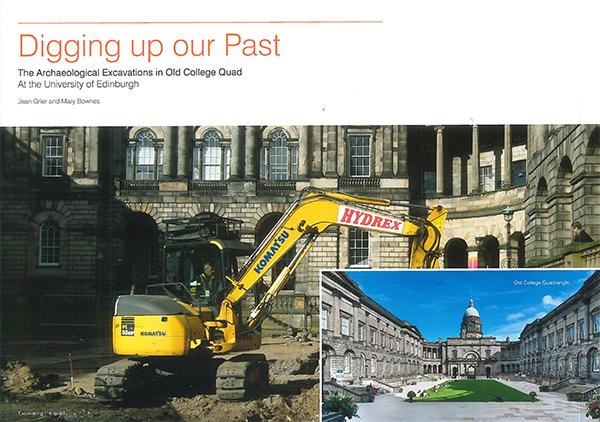Unearthing secrets and supporting students
'Digging Up Our Past' is a new book looking at the historical artefacts found during 2011's archaeological dig in Old College Quad. We spoke to co-author Mary Bownes about why the finds have been so significant, and how sales of the book will help current students.

What inspired you to write a book about the archaeological dig in Old College Quad?
I had the privilege of being asked by the Principal to become Chair of the project board for the transformation of Old College Quad from a gravel car park to the wonderful grass space we see today. As part of this process the University undertook an archaeological dig to find out what was buried beneath the car park. The dig was carried out by Addyman Archaeology and overseen by the City of Edinburgh Council. We fully expected to see evidence of previous buildings, including the original University Library, but not as much as we actually found.
The biggest surprise, however, was how much we found out about our scientific past, particularly due to findings relating to renowned chemist Joseph Black and his laboratories, which were situated where Old College stands today. As a scientist myself, I found the diversity of what we discovered and the process of the dig extremely interesting. The ultimate plan is to publish two large volumes covering all of the archaeological finds and their significance, but in my capacity as Vice-Principal of Community Engagement, I felt that it was really important to engage not only University staff and students but also the wider public in what the University had found in a very accessible way, which I hope 'Digging Up Our Past' achieves.
Why will alumni find the book particularly interesting?
I think knowing about the history of your alma mater is something that starts from your time as a student and really develops after graduation. Everyone who attended the University is likely to have been inside Old College and stood in the quad, whether that be before or after the renovations - perhaps even during the dig when it was a big, muddy site. Having an accessible reference point for how we found out more about our past and our connections with earlier academic study will be very appealing to alumni. It's something they can be proud of.
In what way does the Old College site hold historical significance for the University and its foundation?
The dig enabled us to find out much more detail about exactly how the University looked at different times in its history and how it connected to the rest of the city. You cannot rely on old paintings and drawings to tell the whole story as they could be inaccurate, altered for artistic licence or even represent an initial plan, rather than the reality of what was built. However, discovering foundations brings precise accuracy.
Soon after the dig and subsequent renovations were completed, I worked with a small start-up company to develop an app which would allow people to virtually walk around the Old College site. It let people travel backwards through time and underneath the site to reveal how it has changed over time, and how at each stage in history it was a key part of the city.
How will proceeds from sales of the book help current students?
The proceeds will help student internships and we decided this for two reasons. The first is rather practical: you can’t raise huge sums of money from sales of a book like this so there is a limited number of ways to make a meaningful impact, but internships is one of them.
Internships give students the chance to gain additional skills that complement those developed on their course, and allow them to engage with a larger project with a real and effective outcome. I would really like these internships to go to students doing something that will have a legacy, such as a publication or an information resource that can be used by a charity or community group. This experience and having to work in collaboration with others will broaden the students’ skillsets that can be applied to a wide variety of careers.
This is your second book on the history of the University (following 2014’s 'Private Giving, Public Good') - do you have another in the pipeline?
I’m project managing the next one which will be written by external expert authors. It will be about the architectural history of the University since it was founded in 1583, including a look at all of its main sites within and beyond the city. This will appear in late spring 2017 and is a collaboration with Historic Scotland.
We also have another booklet on the way, but the topic is a secret - so look out for a surprise in the summer!
The archaeologist’s view
Archaeologist Tom Addyman explains why the Old College Quad dig proved so interesting:
It was a fascinating project – far more extensive than we first imagined it would be. In terms of finds, it is difficult to single anything out. Skeletons can tell us so much these days thanks to advanced analytic techniques, and work on them is still going on. But we also found typeface of the old printing house and have been able to match that to early books in the University collections. And, of course, the chemical residues we found in the old chemistry stores are both interesting and highly toxic!
More information

'Digging Up Our Past' by Mary Bownes and Jean Grier is available at the University’s Visitor Centre and online.

